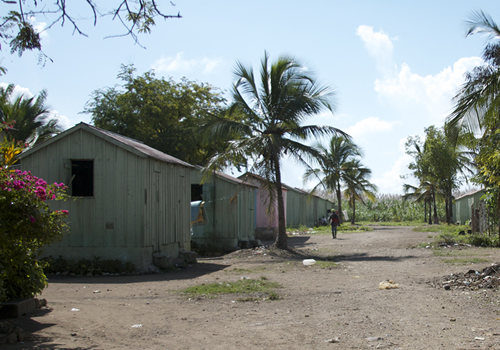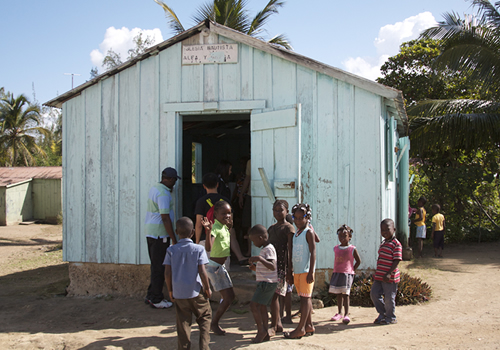One of the ways the international community responds to global health concerns is through volunteer educational trips – often called service learning or voluntourism — which see students or professionals travel to communities to take part in short-term activities that aim to help the local population.
Helen Dimaras, an assistant professor in U of T’s Dalla Lana School of Public Health, found herself wondering if such volunteer interventions really do help. What if these volunteer trips held more benefit for students in the Global North and were even causing harm to the very communities they were trying to help in the Global South?
So Dimaras and her colleague Lawrence Loh set out to investigate and in 2014, they took a team of undergraduate students from Dimaras’ third-year human biology course on Global Health Research to the Dominican Republic to find out more.
The Dominican Republic shares the island of Hispaniola with its poorer neighbour, Haiti. Migrant workers travel from Haiti to work on large sugar plantations, and live in communities connected to the plantations, called bateyes.
The living conditions for migrant workers are difficult: there is no running water or electricity and many bateyes don’t have latrines. Health care is an ongoing concern with high levels of malnutrition and dehydration amongst the children.

“Given that my global health research undergraduate students are often the targets of these types of trips, I thought it important to combine this study with their coursework. We travelled to La Romana with The 53rd Week, an organization which advocates for more responsible, locally integrated efforts of foreigners visiting to work in bateyes,” said Dimaras.
The students on the 2014 trip conducted surveys on the perceptions of short-term volunteerism from the perspective of foreign volunteers, local communities (‘recipients’ of the volunteer work) and local organizations (‘hosts’ of the foreign volunteer teams). They found some notable perceptions associated with short-term volunteering: recipients of the volunteer work often emphasized the material benefits — medicine, food and so on. There was also evidence of stereotypes suggesting that international volunteers have superior knowledge and skills compared with the recipients.
The study resulted in four published articles and the development of a theory of change framework to improve volunteer practices in La Romana.
Fast forward to spring 2017: Dimaras and another group of undergraduates returned to the bateyes to complete the ‘knowledge to action’ cycle by sharing the research results with volunteers, communities and organizations. Their goal: to generate awareness and inspire action for change.
“It was important that we go again in 2017 so that the research does not remain in the academic world, but reaches the individuals and organizations who have the opportunity to apply the results and change practices,” said Dimaras.

She says their research highlighted “the need for the voice of the community to be heard to ensure that health care interventions are designed and implemented with their input.”
The research also pointed away from voluntourist efforts that are “marked by a power differential, and the assumption that privileged students from western countries have something to offer to less privileged or marginalized societies,” and more toward mutually beneficial partnerships.
“Each partner has something to offer towards meeting a common goal or solving a common challenge. A partnership takes time to develop and develops organically,” said Dimaras. This can be challenging in the context of short-term visits by different volunteers but “when solid partnerships are built from the ground up and over time, then the roles where each partner fits can emerge naturally.”
Orianna Mak, a fourth-year Global Health specialist, says taking part in the trip to the Dominican Republic allowed her to apply her knowledge in a tangible, real-world situation in order to enact real change.
“Having been involved quite heavily in the international volunteer world, I have always been interested in critiques of short-term volunteering and wanted to understand ways to optimize it,” said Mak.
“The earlier research emphasizes the importance of authentic partnerships,” said Mak. “We constantly talk about how important this is in Global Health, but it wasn’t until going to the Dominican Republic and learning to navigate complex social relationships that I fully appreciated what that meant.”
Nikita Gupta, a double major in Global Health and Biochemistry, with a minor in English, said the trip was an opportunity to learn more about the unique challenges researchers face in the field.
“My week in the Dominican Republic exposed me to the intricacies surrounding global health research, including building authentic partnerships and empowering local community members and students to initiate change,” said Gupta.
“One of the principles for global health research is commitment to the future. This is the only way to build solidarity and true partnership — when your partners see that you’re in it for the long haul,” said Dimaras.
“Returning to one of the bateyes where we had done interviews in the past, we met the son of the bateye’s health promoters. He recognized his mom in one of our photos from the visit in 2014. He opened up to us simply because of that past connection.”
The undergraduate research trips to the Dominican Republic were offered as part of the Faculty of Arts & Science International Course Modules (ICM) program which enables students to travel to different locations in the world to directly experience the phenomena they are studying in class.
Knowledge translation and exchange in the bateyes; discussions/presentations at the Universidad Central Del Este (and observation of their public health outreach in the bateyes near the university – those are the UCE Epidemiology students in the yellow shirts);

